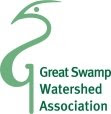By Jim Northrop, GSWA Member
The Dilemma: Nature or Technology?
In 1959, it was discovered that the Port Authority of New York and New Jersey was developing plans to acquire the land we call “The Great Swamp,” and there to construct a "jetport." Their aims were ambitious, and their jetport would be one of the largest in the world. Many residents of the area were up in arms, but they were opposed by powerful pro-business interests.
In time, however, a defensive strategy emerged -- transfer as much land as possible from strategic places in the middle of the Great Swamp, to the Federal Government, for use as a wildlife sanctuary. It was believed this would keep the land out of the reach of the Port Authority, and thus defeat the jetport plan.
A Captain of Industry Becomes Engaged In Open Space Issues
After 1907, when M. Hartley Dodge married Geraldine Stillman Rockefeller, youngest daughter of William Rockefeller, brother of John D. Rockefeller and a founder of Standard Oil Company (NJ), the young couple became among the largest landowners in the Great Swamp area. It was known that Dodge was a generous donor of land to the newly-formed Morris County Park Commission. In 1957, Mr. Dodge and others donated over 50 acres to the Morris County Park Commission for Loantaka Park, the first link in the Loantaka Brook Reservation. But the actual extent of his concern for saving the Great Swamp was not revealed until later.
Dodge was the retired Chairman of the Board of the Remington Arms Company and had served for many years as a Director of the Equitable Life Assurance Society, and the Delaware, Lackawanna & Western Railroad. He was also a member of various other boards. He lived in Madison Borough and made substantial contributions (usually anonymously) to local causes. Born in 1881, “Marcy” Dodge was a friend of the rich and famous, and was descended from a founder of the Phelps-Dodge Corporation.
Launching the “Defensive Strategy”
In September, 1960 almost 1,000 acres of private land was quietly transferred to the North American Wildlife Foundation, a prestigious national conservation organization in Washington, D.C. There was a small problem -- 1,000 acres was not enough land to interest the Dept. of the Interior, so the North American Wildlife Foundation had agreed to hold the title until more land was acquired and the Federal Government would accept it. It was known that Marcellus Hartley Dodge had been a trustee of the North American Wildlife Foundation for many years. The newspapers hinted that M. Hartley Dodge was behind it all, but Dodge himself was unavailable for comment. It was later established that most of the money to buy up the acreage had come from Mr. Dodge, and that he had done much of the prodding to win over landowners so they would sell their property.
It soon became evident that a broader base of money and support was needed to carry out the conservationists’ plan. Dodge was instrumental in forming the Great Swamp Committee. It is said that M. Hartley Dodge watched anxiously from the sidelines, knowing that much more private land in the Great Swamp area must be acquired before the U.S. Dept. of the Interior would accept the gift, and thereafter take responsibility to operate it as a wildlife sanctuary. Dodge himself dipped into his own pocket several times to prevent a land purchase from getting away.
In June, 1961, the Regional Director of the U.S. Bureau of Sport Fisheries and Wildlife promised that a gift of 3,000 acres would guarantee a national wildlife refuge, and that 2,000 acres would be large enough for the Fish and Wildlife Service to begin active management. He also agreed to have signs erected to indicate the presence of the U.S. Government.
Closing the Gaps Was Unexpectedly Difficult
The conservationists were far from being out of the woods. The Dept. of the Interior needed a management unit of contiguous or at least closely spaced properties. Much of the land bought thus far was widely scattered within the whole refuge boundary. To close in these areas, the Great Swamp Committee wanted at least $600,000. (The final amount spent was almost double.) By November, 1961, a total of $450,000 had been contributed by 1,200 individuals and more than 100 organizations. However, by far the largest proportion had been contributed by a few generous families -- more than $300,000 had come from M. Hartley Dodge and $50,000 from Mrs. Dodge.
On Christmas Day 1963, M. Hartley Dodge died. He had done what he could, whenever he could, to save his beloved swamp, and he had the satisfaction of knowing that the refuge would soon be a reality. Five months later, more than a thousand people watched as the U.S. Secretary of the Interior formally received a gift of 2,600 acres of land worth over $1 million, to form the nucleus of the Great Swamp National Wildlife Refuge.
Though Marcellus Hartley Dodge had been dead for five months, surely his spirit was present. Where did this dedication ceremony take place? At the M. Hartley Dodge estate.
Subscribe to:
Post Comments (Atom)


No comments:
Post a Comment